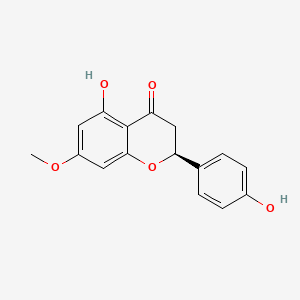| MeSH term | MeSH ID | Detail |
|---|---|---|
| Acne Vulgaris | D000152 | 35 associated lipids |
Sakuranetin
Sakuranetin is a lipid of Polyketides (PK) class. Sakuranetin is associated with abnormalities such as and Neurodegenerative Disorders. The involved functions are known as inhibitors, Drug Interactions, aldehyde reductase activity, Antiinflammatory Effect and antagonists. Sakuranetin often locates in Vacuole and Cell surface. The associated genes with Sakuranetin are PTPN1 gene.
Cross Reference
Introduction
To understand associated biological information of Sakuranetin, we collected biological information of abnormalities, associated pathways, cellular/molecular locations, biological functions, related genes/proteins, lipids and common seen animal/experimental models with organized paragraphs from literatures.
What diseases are associated with Sakuranetin?
Sakuranetin is suspected in Neurodegenerative Disorders and other diseases in descending order of the highest number of associated sentences.
Related references are mostly published in these journals:
| Disease | Cross reference | Weighted score | Related literature |
|---|
Possible diseases from mapped MeSH terms on references
We collected disease MeSH terms mapped to the references associated with Sakuranetin
PubChem Associated disorders and diseases
What pathways are associated with Sakuranetin
There are no associated biomedical information in the current reference collection.
PubChem Biomolecular Interactions and Pathways
Link to PubChem Biomolecular Interactions and PathwaysWhat cellular locations are associated with Sakuranetin?
Visualization in cellular structure
Associated locations are in red color. Not associated locations are in black.
Related references are published most in these journals:
| Location | Cross reference | Weighted score | Related literatures |
|---|
What functions are associated with Sakuranetin?
Related references are published most in these journals:
| Function | Cross reference | Weighted score | Related literatures |
|---|
What lipids are associated with Sakuranetin?
There are no associated biomedical information in the current reference collection.
What genes are associated with Sakuranetin?
Related references are published most in these journals:
| Gene | Cross reference | Weighted score | Related literatures |
|---|
What common seen animal models are associated with Sakuranetin?
There are no associated biomedical information in the current reference collection.
NCBI Entrez Crosslinks
All references with Sakuranetin
Download all related citations| Authors | Title | Published | Journal | PubMed Link |
|---|---|---|---|---|
| Liu H et al. | [Chemical constituents contained in Populus tomentosa]. | 2012 | Zhongguo Zhong Yao Za Zhi | pmid:22860454 |
| Tohno H et al. | Evaluation of estrogen receptor Beta binding of pruni cortex and its constituents. | 2010 | Yakugaku Zasshi | pmid:20606380 |
| Ogawa S et al. | OsMYC2, an essential factor for JA-inductive sakuranetin production in rice, interacts with MYC2-like proteins that enhance its transactivation ability. | 2017 | Sci Rep | pmid:28067270 |
| Taguchi L et al. | A flavanone from Baccharis retusa (Asteraceae) prevents elastase-induced emphysema in mice by regulating NF-κB, oxidative stress and metalloproteinases. | 2015 | Respir. Res. | pmid:26122092 |
| Zhang L et al. | Three flavonoids targeting the beta-hydroxyacyl-acyl carrier protein dehydratase from Helicobacter pylori: crystal structure characterization with enzymatic inhibition assay. | 2008 | Protein Sci. | pmid:18780820 |
| Morris CE et al. | Expanding the paradigms of plant pathogen life history and evolution of parasitic fitness beyond agricultural boundaries. | 2009 | PLoS Pathog. | pmid:20041212 |
| Perry NB and Foster LM | Antiviral and antifungal flavonoids, plus a triterpene, from Hebe cupressoides. | 1994 | Planta Med. | pmid:7997487 |
| Jung YH et al. | The rice (Oryza sativa) blast lesion mimic mutant, blm, may confer resistance to blast pathogens by triggering multiple defense-associated signaling pathways. | 2005 | Plant Physiol. Biochem. | pmid:15907692 |
| Seo S et al. | Cyanide, a coproduct of plant hormone ethylene biosynthesis, contributes to the resistance of rice to blast fungus. | 2011 | Plant Physiol. | pmid:21075959 |
| Mori M et al. | Isolation and molecular characterization of a Spotted leaf 18 mutant by modified activation-tagging in rice. | 2007 | Plant Mol. Biol. | pmid:17273822 |
